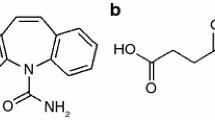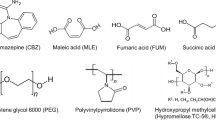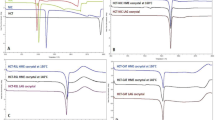Abstract
In this work, carbamazepine (CBZ), an anticonvulsant drug was cocrystallized with several structurally complement coformers (coformers with amide, acid and hydrazide functional groups) to enhance its dissolution. CBZ formed a cocrystal phase with acetamide (ACE) when mixtures of CBZ and ACE (containing CBZ mole fractions, XCBZ of 0.25, 0.33, 0.5, and 0.67) were subjected to solid-state grinding (SSG), evaporative crystallization (EC), slurry conversion (SC), and slow cooling crystallization (SLC). Upon heating, the CBZ-ACE cocrystal phase formed from CBZ-ACE mixtures containing XCBZ of 0.25, 0.33 and 0.67 underwent solid-state phase transition to CBZ form I and CBZ cocrytsal phase obtained from the CBZ-ACE mixture containing XCBZ of 0.5 converted to CBZ form III. Interestingly, slow cooling cocrystallization experiments resulted in crystallization of a cocrystal as well as the CBZ dihydrate forms. The powder dissolution studies demonstrated that among the different CBZ-ACE-SSG cocrystal phases, CBZ-ACE-SSG-XCBZ-0.33 cocrystal exhibited 7.47 times improved dissolution whereas the CBZ eutectic phase with nicotinic acid hydrazide (NAH) exhibited 4.93 times increased dissolution when compared to raw CBZ.









Similar content being viewed by others
Change history
03 February 2021
The original article can be found online at <ExternalRef><RefSource>https://doi.org/10.1208/s12249-021-01930-1</RefSource><RefTarget Address="10.1208/s12249-021-01930-1" TargetType="DOI"/></ExternalRef>
References
Ullah M, Hussain I, Sun CC. The development of carbamazepine-succinic acid cocrystal tablet formulations with improved in vitro and in vivo performance. Drug Dev Ind Pharm. 2016;42:969–76.
https://pubchem.ncbi.nlm.nih.gov/compound/Carbamazepine#section=Solubility. Accessed on 26 March 2020.
Grzesiak AL, Lang M, Kim K, Matzger AJ. Comparison of the four anhydrous polymorphs of carbamazepine and the crystal structure of form I. J Pharm Sci. 2003;92:2260–71.
Harris RK, Ghi PY, Puschmann H, Apperly DC, Griesser UJ, Hammond RB, et al. Structural studies of the polymorphs of carbamazepine, its dihydrate, and two solvates. Org Process Res Dev. 2005;9:902–10.
Arlin J, Price LS, Price SL, Florence AJ. A strategy for producing predicted polymorphs: catemeric carbamazepine form V. Chem Commun. 2011;47:7074–6.
Laine E, Tuominen V, Ilvessalo P, Kahela P. Formation of dihydrate from carbamazepine anhydrate in aqueous conditions. Int J Pharm. 1984;20:307–14.
ter Horst JH, Deij MA, Cains PW. Discovering new co-crystals. Cryst Growth Des. 2009;9:1531–7.
Sathisaran I, Dalvi SV. Cocrystallization of carbamazepine with amides: Cocrystal and eutectic phases with improved dissolution. J Mol Struct. 2019;1193:398–415.
Fleischman SG, Kuduva SS, McMahon JA, Moulton B, Walsh RDB, Rodriguez-Hornedo N, et al. Crystal engineering of the composition of pharmaceutical phases: multiple-component crystalline solids involving carbamazepine. Cryst Growth Des. 2003;3:909–19.
Porter WW III, Elie SC, Matzger AJ. Polymorphism in carbamazepine cocrystals. Cryst Growth Des. 2008;8:14–6.
Habgood M, Deij MA, Mazurek J, Price SL, ter Horst JH. Carbamazepine co-crystallization with pyridine carboxamides: rationalization by complementary phase diagrams and crystal energy landscapes. Cryst Growth Des. 2010;10:903–12.
Lu E, Rodriguez-Hornedo N, Suryanarayanan R. A rapid thermal method for cocrystal screening. Cryst Eng Comm. 2008;10:665–8.
Childs SL, Rodriguez-Hornedo N, Reddy LS, Jayasankar A, Maheshwari C, McCausland L, et al. Screening strategies based on solubility and solution composition generate pharmaceutically acceptable cocrystals of carbamazepine. Cryst Eng Comm. 2008;10:856–64.
Jayasankar A, Reddy LS, Bethune SJ, Rodriguez-Hornedo N. Role of cocrystal and solution chemistry on the formation and stability of cocrystals with different stoichiometry. Cryst Growth Des. 2009;9:889–97.
Li Z, Matzger AJ. Influence of coformer stoichiometric ratio on pharmaceutical cocrystal dissolution: three cocrystals of carbamazepine/4-aminobenzoic acid. Mol Pharm. 2016;13:990–5.
Bethune SJ, Huang N, Jayasankar A, Rodriguez-Hornedo N. Understanding and predicting the effect of cocrystal components and pH on cocrystal solubility. Cryst Growth Des. 2009;9:3976–88.
Drozd KV, Manin AN, Churakov AV, Perlovich GL. Novel drug-drug cocrystals of carbamazepine with para-aminosalicylic acid: screening, crystal structures and comparative study of carbamazepine cocrystal formation thermodynamics. Cryst Eng Comm. 2017;19:4273–86.
Vishweshwar P, McMahon JA, Oliveira M, Peterson ML, M., Zaworotko J. The predictably elusive form II of aspirin. J Am Chem Soc. 2005;127:16802–3.
Moradiya H, Islam MT, Woollam GR, Slipper IJ, Halsey S, Snowden MJ, et al. Continuous cocrystallization for dissolution rate optimization of a poorly water-soluble drug. Cryst Growth Des. 2014;14:189–98.
Abramov YA. Current computational approaches to support pharmaceutical solid form selection. Org Process Res Dev. 2013;17:472–85.
Abramov YA, Loschen C, Klamt A. Rational coformer or solvent selection for pharmaceutical cocrystallization or desolvation. J Pharm Sci. 2012;101:3687–97.
Fu Q, Han Y, Xie Y, Gong N, Guo F. Carbamazepine cocrystals with several aromatic carboxylic acids in different stoichiometries: structures and solid state characterization. J Mol Struct. 2018;1168:145–52.
Salan J, Anderson SR, Am EDJ, A method to produce and scale-up cocrystals and salts via resonant acoustic mixing. 2015; EP 2845852 A1.
Moradiya HG, Islam MT, Halsey S, Maniruzzaman M, Chowdhry BZ, Snowden MJ, et al. Continuous cocrystallisation of carbamazepine and trans-cinnamic acid via melt extrusion processing. Cryst Eng Comm. 2014;16:3573–83.
Sathisaran I, Skieneh JM, Rohani S, Dalvi SV. Curcumin eutectics with enhanced dissolution rates: binary phase diagrams, characterization, and dissolution studies. J Chem Eng Data. 2018;63:3652–71.
Naima Z, Siro T, Juan-Manuel GD, Chantal C, Rene C, Jerome D. Interactions between carbamazepine and polyethylene glycol (PEG) 6000: characterisations of the physical, solid dispersed and eutectic mixtures. Eur J Pharm Sci. 2001;12:395–404.
Kristic M, Popovic M, Dobricic V, Ibric S. Influence of solid drug delivery system formulation on poorly water-soluble drug dissolution and permeability. Molecules. 2015;20:14684–98.
Hirasawa N, Okamoto H, Danjo K. Lactose as a low molecular weight carrier of solid dispersions for carbamazepine and ethenzamide. Chem Pharm Bull (Tokyo). 1999;47:417–20.
Rane Y, Mashru R, Sankalia M, Sankalia J. Effect of hydrophilic swellable polymers on dissolution enhancement of carbamazepine solid dispersions studied using response surface methodology. AAPS Pharm Sci Tech. 2007;8:27.
Buist AR, Kennedy AR. Ionic Cocrystals of pharmaceutical compounds: sodium complexes of carbamazepine. Cryst Growth Des. 2014;14:6508–13.
Buist AR, Edgeley DS, Kabova EA, Kennedy AR, Hooper D, Rollo DG, et al. Salt and ionic cocrystalline forms of amides: protonation of carbamazepine in aqueous media. Cryst Growth Des. 2015;15:5955–62.
Reck G, Thiel W. 1:1 molecular complex of carbamazepine and ammonium chloride. Pharmazie. 1991;46:509.
Lobmann K, Grohganz H, Laitinen R, Strachan C, Rades T. Amino acids as co-amorphous stabilizers for poorly water soluble drugs—part 1: preparation, stability and dissolution enhancement. Eur J Pharm Biopharm. 2013;85:873–81.
Ueda H, Wu W, Lobmann K, Grohganz H, Mullertz A, Rades T. Application of a salt coformer in a co-amorphous drug system dramatically enhances the glass transition temperature: a case study of the ternary system carbamazepine, citric acid, and L-arginine. Mol Pharm. 2018;15:2036–44.
Cherukuvada S, Row TNG. Comprehending the formation of eutectics and cocrystals in terms of design and their structural interrelationships. Cryst Growth Des. 2014;14:4187–98.
Sathisaran I, Dalvi SV. Understanding rationale behind carbamazepine co-crystallization with acids, amides and hydrazides. Acta Cryst. 2017;A73:C435.
Sathisaran I, Dalvi SV. Engineering cocrystals of poorly water-soluble drugs to enhance dissolution in aqueous medium. Pharmaceutics. 2018;10(3):108.
Cherukuvada S, Nangia A. Eutectics as improved pharmaceutical materials: design, properties and characterization. Chem Commun. 2014;50:906–23.
https://www.accessdata.fda.gov/drugsatfda_docs/label/2012/022118s005lbl.pdf_Accessed 8 July 2020.
Thipparaboina R, Thumuri D, Chavan R, Naidu VGM, Shastri NR. Fast dissolving drug-drug eutectics with improved compressibility and synergistic effects. Eur J Pharm Sci. 2017;104:82–9.
Goud NR, Suresh K, Sanphui P, Nangia A. Fast dissolving eutectic compositions of curcumin. Int J Pharm. 2012;439:63–72.
Cherukuvada S, Nangia A. Fast dissolving eutectic compositions of two anti-tubercular drugs. Cryst Eng Comm. 2012;14:2579–88.
Figueiredo CBM, Nadvorny D, Vieira ACQM, Sobrinho JLS, Neto PJR, Lee PI, et al. Enhancement of dissolution rate through eutectic mixture and solid solution of posaconazole and benznidazole. Int J Pharm. 2017;525:32–42.
Chadha K, Karan M, Chadha R, Bhalla Y, Vasisht K. Is failure of cocrystallization actually a failure? Eutectic formation in cocrystal screening of hesperetin. J Pharm Sci. 2017;106:2026–36.
Sheldrick GM. SHELXT-integrated space-group and crystal-structure determination. Acta Cryst. 2015;A71:3–8.
Sheldrick GM. Crystal structure refinement with SHELXL. Acta Cryst. 2015;C71:3–8.
Dolomanov OV, Bourhis LJ, Gildea RJ, Howard JAK, Puschmann H. OLEX2: a complete structure solution, refinement and analysis program. J Appl Crystallogr. 2009;42:339–41.
Huang Y, Zhou L, Yang W, Li Y, Yang Y, Zhang Z, et al. Preparation of theophylline-benzoic acid cocrystal and on-line monitoring of cocrystallization process in solution by Raman spectroscopy. Crystals. 2019;9:329. https://doi.org/10.3390/cryst9070329.
Tian F, Zeitler JA, Strachan CJ, Saville DJ, Gordon KC, Rades T. Characterizing the conversion kinetics of carbamazepine polymorphs to the dihydrate in aqueous suspension using Raman spectroscopy. J Pharm Biomed Anal. 2006;40:271–80.
Qu H, Louhi-Kultanen M, Kallas J. Solubility and stability of anhydrate/hydrate in solvent mixtures. Int J Pharm. 2006;321:101–7.
Young WWL, Suryanarayanan R. Kinetics of transition of anhydrous carbamazepine to carbamazepine dihydrate in aqueous suspensions. J Pharm Sci. 1991;80:496–500.
Brittain HG. Fluorescence studies of the transformation of carbamazepine anhydrate form III to its dihydrate phase. J Pharm Sci. 2004;93:375–83.
Murphy D, Rodriguez-Cintron F, Langevin B, Kelly RC, Rodriguez-Hornedo N. Solution-mediated phase transformation of anhydrous to dihydrate carbamazepine and the effect of lattice disorder. Int J Pharm. 2002;246:121–34.
Babu NJ, Nangia A. Solubility advantage of amorphous drugs and pharmaceutical cocrystals. Cryst Growth Des. 2011;11:2662–79.
Johnston A, Johnston BF, Kennedy AR, Florence AJ. Targeted crystallization of novel carbamazepine solvates based on retrospective random forest classification. Cryst Eng Comm. 2008;10:23–5.
Good DJ, Rodriguez-Hornedo N. Solubility advantage of pharmaceutical cocrystals. Cryst Growth Des. 2009;9:2252–64.
Shevchenko A, Miroshnyk I, Pietila L, Haarala J, Salmia J, Sinervo K, Mirza S, van Veen B, Kolehmainen E, Nonappa, Yliruusi J, Diversity in Itraconazole Cocrystals with aliphatic dicarboxylic acids of varying chain length, Cryst Growth Des 2013; 13: 4877–4884.
https://pubchem.ncbi.nlm.nih.gov/compound/Pimelic-acid#section=pKa. Accessed 30 July 2020.
https://en.wikipedia.org/wiki/Suberic_acidhttps://hmdb.ca/metabolites/HMDB0000893. Accessed 31 July 2020.
https://pubchem.ncbi.nlm.nih.gov/compound/Azelaic-acid#section=pKa. Accessed 30 July 2020.
https://www.drugbank.ca/drugs/DB07645. Accessed 30 July 2020.
Abraham MH, Grellier PL, Kamlet MJ, Doherty RM, Taft RW, Abboud JM. The use of scales of hydrogen-bond acidity and basicity in organic chemistry. Rev Port Quim. 1989;85:85–92.
https://pubchem.ncbi.nlm.nih.gov/compound/acetamide#section=Solubility. Accessed 11 December 2018.
https://pubchem.ncbi.nlm.nih.gov/compound/pimelic_acid#section=Solubility. Accessed 11 December 2018.
https://www.chemicalbook.com/ChemicalProductProperty_EN_CB2775043.htm. Accessed 11 December 2018.
https://pubchem.ncbi.nlm.nih.gov/compound/azelaic_acid#section=Solubility. Accessed 11 December 2018.
https://pubchem.ncbi.nlm.nih.gov/compound/sebacic_acid#section=Solubility. Accessed 11 December 2018.
https://pubchem.ncbi.nlm.nih.gov/compound/isoniazid#section=Solubility. Accessed 11 December 2018.
https://www.chemicalbook.com/ChemicalProductProperty_EN_CB5491636.htm. Accessed 18 August 2020.
https://pubchem.ncbi.nlm.nih.gov/compound/Maleichydrazide#section=Solubility. Accessed 30 July 2020.
Guzman HR, Tawa M, Zhang Z, Ratanabanangkoon P, Shaw P, Gardner CR, et al. Combined use of crystalline salt forms and precipitation inhibitors to improve oral absorption of celecoxib from solid oral formulations. J Pharm Sci. 2007;96:2686–702.
Maheshwari C, Andre V, Reddy S, Roy L, Duarte T, Rodriguez-Hornedo N. Tailoring aqueous solubility of a highly soluble compound via cocrystallization: effect of coformer ionization, pHmax and solute-solvent interactions. Cryst Eng Comm. 2012;14:4801–11.
Sathisaran I, Dalvi SV. Crystal engineering of curcumin with salicylic acid and hydroxyquinol as coformers. Cryst Growth Des. 2017;17:3974–88.
Sovago I, Gutmann MJ, Senn HM, Thomas LH, Wilson CC, Farrugia LJ. Electron density, disorder and polymorphism: high-resolution diffraction studies of the highly polymorphic neuralgic drug carbamazepine. Acta Cryst. 2016;B72:39–50.
Acknowledgments
The authors acknowledge the Central Instrumentation Facility (CIF) of Indian Institute of Technology Gandhinagar (IITGN) for providing access to various instruments, namely PXRD, FE-SEM, DSC, and FIST-SCXRD, respectively. The authors are very grateful to Prof. Celine Besnard, Senior Scientist, University of Geneva for her valuable suggestions in collection of SCXRD data and usage of CryAlis Pro software in data analysis.
Author information
Authors and Affiliations
Corresponding author
Ethics declarations
Conflict of Interest
The authors declare that they have no conflict of interest.
Additional information
Publisher’s Note
Springer Nature remains neutral with regard to jurisdictional claims in published maps and institutional affiliations.
The original online version of this article was revised: In the original article, only two supplemental figures (S1 and S30) in the ESM were published, whereas 37 figures (S2-S29 and S31-S39), a table S1 and a reference were not.
Supplementary Information
The chemical structures of CBZ, ACE, PMA, SBA, AZA, SEA, ISN, NAH and MAH, the PXRD patterns of fresh unheated and heated CBZ-ACE-SSG mixtures containing CBZ mole fractions of 0.25, 0.33, 0.5 and 0.67 are provided in the supplementary information. The PXRD patterns of raw ACE, raw CBZ and CBZ-ACE cocrystals prepared by EC, SC and SLC, the Raman spectra of raw ACE, raw CBZ and CBZ-ACE cocrystals prepared by EC, SC and SLC, and SEM micrographs of CBZ-ACE cocrystals prepared by EC are shown in the supplementary material. A snapshot of the lattice of CBZ-ACE cocrystal prepared by EC of CBZ-ACE-SSG-XCBZ-0.25 mixture in acetone-toluene (1:1 volume ratio) visualized using CryAlisPro software, the PXRD patterns and Raman spectra of CBZ dihydrates prepared by SLC of CBZ-ACE-XCBZ-0.5 and 0.67 in acetone and toluene, a schematic representation of the proposed non-covalent intermolecular interaction (hydrogen bonding) between CBZ and ACE in CBZ-ACE cocrystal, the PXRD patterns of raw CBZ, CBZ-ACE-XCBZ-0.25, 0.33, 0.5, 0.67 cocrystal phases. The DSC thermograms of SSG mixtures of CBZ-PMA, CBZ-SBA, CBZ-AZA, CBZ-SEA, CBZ-ISN, CBZ-NAH and CBZ-MAH pairs containing various CBZ mole fractions ranging from 0 to 1, the binary phase diagrams of CBZ-PMA, CBZ-AZA, CBZ-SEA and CBZ-NAH systems, PXRD patterns of CBZ-PMA, CBZ-AZA, CBZ-SEA and CBZ-NAH eutectic compositions, the PXRD patterns of the CBZ-ACE cocrystal prepared with XCBZ of 0.33, 0.5 and 0.67, CBZ-PMA-XCBZ-0.25 eutectic, CBZ-SBA-XCBZ-0.5 eutectic, CBZ-AZA-XCBZ-0.33 eutectic, CBZ-SEA-XCBZ-0.5 eutectic, CBZ-ISN-XCBZ-0.5 eutectic and CBZ-NAH-XCBZ-0.33 eutectic phases recorded before and after the powder dissolution experiments and a table presenting the Raman band assignments to the molecular vibrations for Raw CBZ, CBZ-ACE cocrystal and CBZ dihydrate prepared by SLC of CBZ-ACE-XCBZ-0.25 and CBZ-ACE-XCBZ-0.5 in acetone are provided in the supplementary material.
ESM 1
(doc 4.47 mb)
Rights and permissions
About this article
Cite this article
Sathisaran, I., Dalvi, S.V. Investigating Cocrystallization of Carbamazepine with Structurally Compatible Coformers: New Cocrystal and Eutectic Phases with Enhanced Dissolution. AAPS PharmSciTech 22, 29 (2021). https://doi.org/10.1208/s12249-020-01888-6
Received:
Accepted:
Published:
DOI: https://doi.org/10.1208/s12249-020-01888-6




